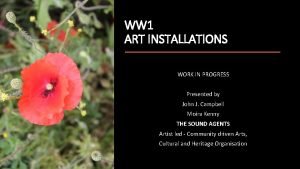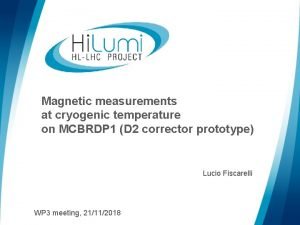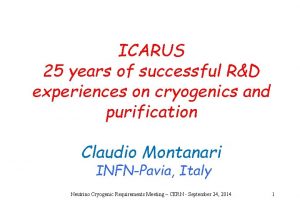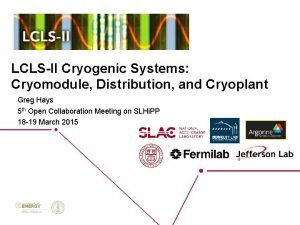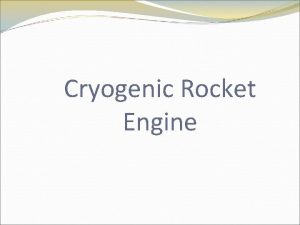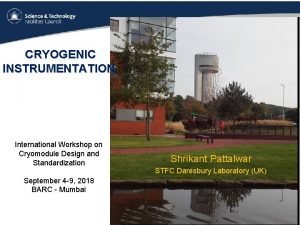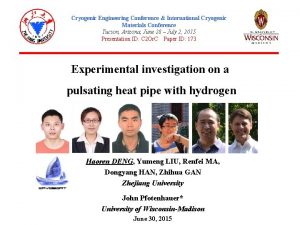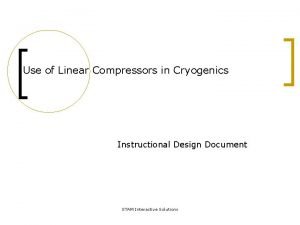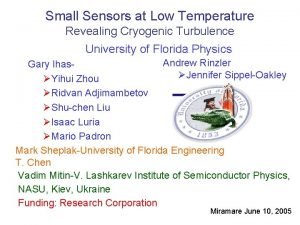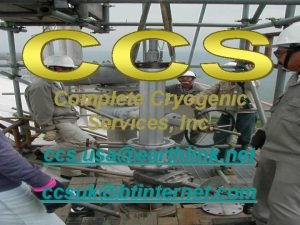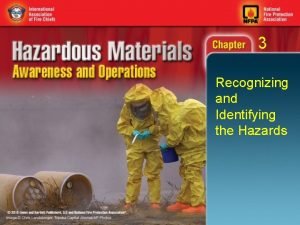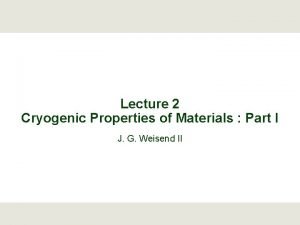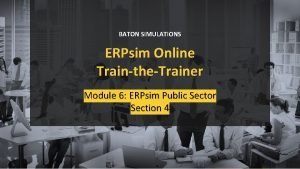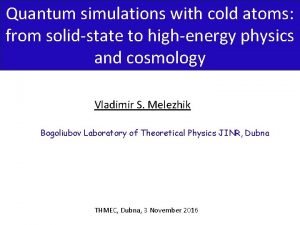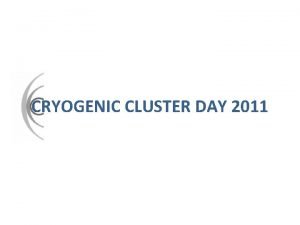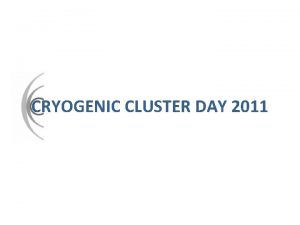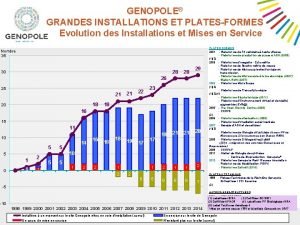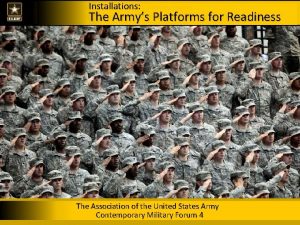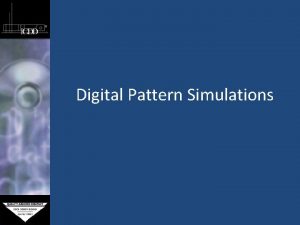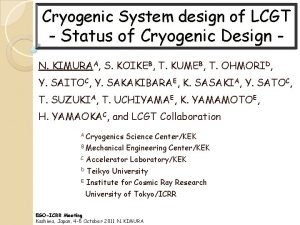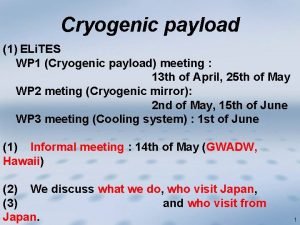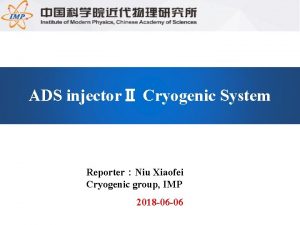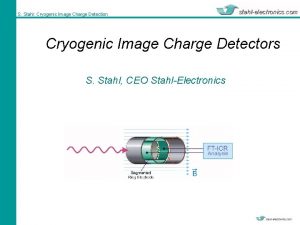Dynamic simulations a useful tool for cryogenic installations

















- Slides: 17

Dynamic simulations: a useful tool for cryogenic installations Benjamin Bradu Process Control Section Industrial Controls & Safety Systems CERN

Contents n Introduction Ø Ø Ø What is dynamic process simulation ? Why using it for cryogenics ? How does it works ? n Main existing tools n Some examples n Potential future projects n Summary B. Bradu. Dynamic simulations: a useful tool for cryogenic installations 2

What is dynamic process simulation ? ■ Simulation = mimic the reality in a computer Need to model your system first ! Ø ■ Dynamic = evolution over time ■ Applied on cryogenic processes: Ø Macroscopic modelling from a process point of view (0 D/1 D) Ø Use of an object-oriented modelling approach Ø Ø Ø Active equipment: valves, heaters, turbines, etc. Passive equipment: pipes, HX, phase separators, etc. Simulate all pressures, temperatures, mass flows over a cryogenic installation ≠ CFD simulation (different objectives, different techniques) B. Bradu. Dynamic simulations: a useful tool for cryogenic installations 3

Why using it for cryogenics ? n Dynamic simulation is a great tool to: Train operators Ø ü Ø Ø Safe training with no risk on the process Simulate failure scenarios (e. g turbine or compressor trips) Simulate occasional events (e. g. cooldown phases) Validate new control strategies Ø ü ü ü No disturbance on the process Fair comparison between strategies Time saving Perform virtual commissioning Ø ü ü Debug safely the control programs Fast validation of complex starting/stopping sequences Commissioning control systems offline Reduce commissioning time with the real plant B. Bradu. Dynamic simulations: a useful tool for cryogenic installations 4

How does it works ? Model each cryo component individually + fluid properties Build your complete model by assembling elementary components + Parametrize each component with your specifications (pipe diameter, valve size, etc. ) Include basic control in model OR: couple it to real control system Define boundary conditions over time Simulate B. Bradu. Dynamic simulations: a useful tool for cryogenic installations 5

Main existing tools ■ Full commercial solutions for cryogenics HYSIS Dynamics (Aspen. Tech, USA) Ø ü Ecosim. Pro + CRYOLIB (EA international, Spain) Ø ü ■ Air-Liquide, CAS, IIT CERN, CEA, ITER, KEK, CAS Homemade libraries/software C-PREST Ø ü Matlab/Simscape Ø ü Ø NIFS CEA Dymola (Modelica) ü University of Torino B. Bradu. Dynamic simulations: a useful tool for cryogenic installations 6

Some examples Some labs in the world doing dynamic simulations for cryogenic processes: NIFS, CERN, CEA, ITER, KEK This is obviously not an exhaustive list… The number of publications using dynamic process simulation is increasing significantly… ICEC conference ICEC 2006 (Prague): 2/422 papers ICEC 2016 (New-Delhi): 8/378 papers Elsevier Cryogenics journal 2005: 1 2010: 1 2013: 5 2014: 5 2015: 4 2016 (Jan-May): 4 B. Bradu. Dynamic simulations: a useful tool for cryogenic installations 7

NIFS ■ ■ LHD = Large Helical Device, Stellerator fusion research in Japan 10 k. W helium cryoplant First large-scale cryoplant dynamic simulation Used to improve some regulations Comparison between simulation and experimental data during a cooldown of the coldbox (R. Maekawa, Cryogenics, 2005) Comparison between different control techniques for the discharge pressure control after a heat pulse (R. Maekawa, ICEC, 2008) B. Bradu. Dynamic simulations: a useful tool for cryogenic installations 8

CERN: Operator training platform Linde 4. 5 K refrigerator for LHC (18 k. W@4. 5 K) Air-Liquide 1. 8 K refrigeration unit for LHC (2. 4 k. W@1. 8 K) Ø 6100 Algebraic equations Ø 500 Differential Equations ØSimulation speed: x 3 Ø 3500 Algebraic equations Ø 320 Differential equations ØSimulation speed : x 80 B. Bradu. Dynamic simulations: a useful tool for cryogenic installations 9

CERN: Simulation results Comparison between simulation and experimental during a LHC 18 k. W refrigerator cooldown (B. Bradu, Ph. D, 2010) Comparison between simulation and experimental data during the LHC final cooldown with cold-compressor in sector 5 -6 (B. Bradu, ICEC, 2008) Comparison between simulated and experimental TS diagram of a LHC 18 k. W refrigerator after cooldown (B. Bradu, Ph. D, 2010) Comparison between simulation and experimental data of the LHC cryogenic pumping line temperature after a quench (B. Bradu, Cryogenics, 2010) B. Bradu. Dynamic simulations: a useful tool for cryogenic installations 10

CERN: Control improvements ■ Control improvements using simulations Ø Ø Cold-compressor speed management HP and LP control Beam screen temperature regulation PID tuning for Gre. C experiment in SM 18 Slow PI Fast PI + FF IMC+FF Comparison of different control techniques for the LHC beam screen temperature control during beam injection (B. Bradu, ICEC, 2016) Comparison of different control techniques for the LHC P 6 warm compression station pressures (B. Bradu, Aussois 2012) Comparison of different PID tunings for the output temperature regulation of Gre. C B. Bradu. Dynamic simulations: a useful tool for cryogenic installations 11

CEA ■ Many dynamic simulations performed at CEA-Grenoble Ø Ø Ø Develop multivariable model-based control techniques (LQ, MPC, etc. ) Control improvements to compensate the fast heat load variations Control improvements to minimize energy consumption CRYOGREEN project between CEA, UJF and CERN Many studies/simulation on HELIOS for heat pulse compensation of JT 60 -SA Comparison of different control techniques for LHC 18 k. W cryoplant. (F. Bonne, CEC, 2013) Comparison between simulation and experimental data during a heat pulse in HELIOS (B. Lagier, Cryogenics, 2014) B. Bradu. Dynamic simulations: a useful tool for cryogenic installations 12

ITER ■ Different dynamic simulations performed for ITER cryogenics Cryoplants + Distribution with Ecosim. Pro (ITER/CERN) Ø ü ü Cryoplant validation under pulsed heat loads Study on the parallel cryoplants management Auxiliary cold-boxes with internal loops with C-PREST (ITER/NIFS) Ø ü Study and validation of different mitigation techniques at ACB level Evolution of the refrigeration power provided by the three refrigerators (L. Gomez, ICEC, 2014) Variation of heat load to Cryoplant in the case of plasma disruption (R. Maekawa, Cryogenics, 2014) B. Bradu. Dynamic simulations: a useful tool for cryogenic installations 13

KEK ■ ■ COMET: Future experiment in J-PARC to produce a muon beam line (Japan) Use of dynamic simulations with Ecosim. Pro Ø Quench simulation is performed to check the maximum pressure in the cooling pipe Pressure and heat curves during a quench. (T. Ki, Cryogenics, 2016). B. Bradu. Dynamic simulations: a useful tool for cryogenic installations 14

Other potential future projects ■ GANIL (France) Ø ■ FAIR (Germany) Ø Ø ■ Beam screen dynamics FCC (Switzerland) Ø ■ Operation of cryogenic plants in parallel Validation of control system HL-LHC (Switzerland) Ø ■ RF cavities cooldown scenario validation Cooldown scenario studies All projects having significant variable heat loads where dynamics play an important role B. Bradu. Dynamic simulations: a useful tool for cryogenic installations 15

Summary ■ Dynamic simulations are really helpful along projects Ø During the design phase ü Validation of dynamic behaviour ü Setup of control schemes Ø During the commissioning phase ü Virtual commissioning ü Tuning of control loops Ø During the operation phase ü Operator training ü Control improvements ü Cryoplant optimization B. Bradu. Dynamic simulations: a useful tool for cryogenic installations 16

 Pengertian embedded system
Pengertian embedded system Architecture of rhipe
Architecture of rhipe Art installations
Art installations Cryogenic temperature
Cryogenic temperature Cryogenic research icarus
Cryogenic research icarus Cryogenic transferlines
Cryogenic transferlines Cold stretching cryogenic vessel
Cold stretching cryogenic vessel Cryogenic engine meaning
Cryogenic engine meaning Cryogenic instrumentation
Cryogenic instrumentation International cryogenic materials conference
International cryogenic materials conference Independence cryogenic engineering
Independence cryogenic engineering Cryogenic pressure transducer
Cryogenic pressure transducer Complete cryogenic services
Complete cryogenic services 704 marking system
704 marking system Cryogenic materials data handbook
Cryogenic materials data handbook Baton simulations
Baton simulations Clinical simulations in nursing education
Clinical simulations in nursing education Simulations for solid state physics
Simulations for solid state physics


